Poverty is about more than income. It is interwoven with other problems that undermine well-being, and is highly correlated with shootings.
1. Poverty is a magnet around which neighborhood problems cluster, and is strongly correlated with shootings.
Poverty, and the problems around it, are amalgamated here as an index of seven factors called “multidimensional” poverty (MDP).
Multidimensional poverty is concentrated mostly in Black and Latino neighborhoods in New York City. Antipoverty policy holds the promise of both increasing equity and improving community safety.

Multidimensional poverty is highly correlated with shootings.


2. Just a few neighborhoods bear the brunt of these conditions.
The correlation between multidimensional poverty and shootings is strong. Of the top eight New York City neighborhoods by MDP in the most recent year available, seven are also in the top eight by shooting rate.
- Brownsville: Highest shooting rate and fourth in MDP
- East Tremont: Third-highest shooting rate and second in MDP
- Mott Haven/Melrose: Fourth-highest shooting rate and third in MDP
- Hunts Point/Longwood: Fifth-highest shooting rate and fifth in MDP
- Morrisania/Crotona: Seventh-highest shooting rate and first in MDP

Neighborhoods with high MDP and high shooting rates also suffer from what sociologist Robert Sampson calls “triple disadvantage.” The connection between disadvantage and shootings is particularly acute when looking at a neighborhood’s own socioeconomic conditions combined with the conditions of neighborhoods that residents visit and are visited by.
- Morrisania/Crotona: Highest triple disadvantage
- East Tremont: Second-highest triple disadvantage
- Mott Haven/Melrose: Third-highest triple disadvantage
- Hunts Point/Longwood: Sixth highest triple disadvantage
- Brownsville: Ninth-highest triple disadvantage

3. Poverty and violence often co-exist and persist in the same neighborhoods. And the gap in social conditions between rich and poor neighborhoods is large.
Since 2006, five Bronx neighborhoods have consistently experienced the highest rates of poverty in New York City:
- East Tremont
- Fordham/University Heights
- Hunts Point/Longwood
- Morrisania/Crotona
- Mott Haven/Melrose

Since 1993, three Brooklyn neighborhoods have consistently experienced the most shootings in New York City:
- Bedford-Stuyvesant
- Brownsville
- East New York

Comparing the New York City neighborhoods with the highest and lowest multidimensional poverty rates shows a stark contrast in both shootings and social distress between poor and non-poor neighborhoods.

4. There are solutions, but they will take time as well as political and societal will.
The gap in well-being between rich and poor can close, creating the conditions in which communities can flourish.
For example, research shows that criminal involvement lessens when the social service net is strengthened: access to food stamps in early childhood, Medicaid eligibility at birth, continuing social security for young people who qualified for SSI before age 18, among other things, can produce decreased poverty, mortality and incarceration rates.
Broader income support programs can lay the foundation for improved well-being, including reduced violence: the Child Tax Credit, implemented during the pandemic, lifted 2.9 million mostly Black and Latino children out of poverty, slashing the child poverty rate by nearly two-thirds.
You can view the raw data from this data story here.